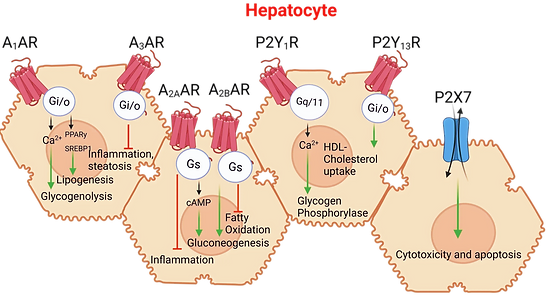Research
The liver is a crucial metabolic organ that regulates systemic glucose and lipid fluxes depending upon the nutrient availability. The parenchymal cells (Hepatocytes) and non-parenchymal cells (Hepatic stellate cells, Kupffer cells, Cholangiocytes, Endothelial cells) regulate liver metabolic processes.
Stages of Non-alcoholic Fatty Liver Disease (NAFLD):
Dysregulation of healthy hepatic metabolism (1) results in the pathogenesis of non-alcoholic fatty
liver (NAFL) (2), non-alcoholic steatohepatitis (NASH) and fibrosis (3), and hepatocellular carcinoma (HCC) (4).
G protein-coupled receptors (GPCRs) are seven-transmembrane cell surface receptors that are expressed in virtually all cell types. GPCRs regulate various pathophysiological processes and hence have been of interest as pharmacological targets for various disorders. The overarching
goal of our lab is to understand GPCRs signalling-mediated regulation of liver metabolism in healthy and diseased conditions.
Jain S and Jacobson KA (2021) Purinergic Signaling in Liver Pathophysiology. Front. Endocrinol. 12:718429. doi: 10.3389/fendo.2021.718429
Our goal is to study GPCRs signalling in liver cell specific manner and their crosstalk with other metabolic tissues in the pathogenesis of liver disorders. In addition, we will screen for GPCRs ligands that could be used for the therapy of NAFL, NASH, fibrosis, and HCC. We are also interested in the identification and characterization of GPCR mutations that may increase the susceptibility to liver disorders. To this end, we will use knockout and transgenic mouse models, primary cell culture systems, in-vitro and in-vivo pharmacology, molecular biology, and biochemical assays. These approaches may help to design novel therapies for liver metabolic disorders.



Funding




